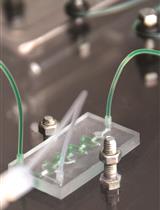- EN - English
- CN - 中文
Rubisco Extraction and Purification from Diatoms
硅藻中的Rubisco提取和纯化
发布: 2017年03月20日第7卷第6期 DOI: 10.21769/BioProtoc.2191 浏览次数: 11804
评审: Scott A M McAdamAgnieszka ZienkiewiczAnonymous reviewer(s)
Abstract
This protocol describes a method to extract ribulose-1,5-bisphosphate carboxylase oxygenase (Rubisco) from diatoms (Bacillariophyta) to determine catalytic performance. This protocol has been adapted from use in cyanobacteria and higher plants (Andrews, 1988; Whitney and Sharwood, 2007). First part (steps A1-A3) of the extraction provides a crude extract of Rubisco that is sufficient for carboxylation assays to measure the Michaelis constant for CO2 (KC) and the catalytic turnover rate (kcatc). However, the further purification steps outlined (steps B1-B4) are needed for measurements of Rubisco CO2/O2 Specificity (SC/O, [Kane et al., 1994]).
Keywords: Rubisco (Rubisco)Background
Ribulose-1,5-bisphosphate carboxylase oxygenase (Rubisco, EC 4.1.1.39) catalyzes the first step in the photosynthetic assimilation of CO2 and thus plays a fundamental role in photosynthesis and the global carbon cycle. Rubisco has been isolated from a wide range of organisms, from archaea, bacteria, algae to plants, and displays a diverse range of kinetics between organisms (Galmes et al., 2014; Tcherkez et al., 2006; Whitney et al., 2011). Knowledge of Rubisco kinetics is a key component for understanding how photosynthesis and thus the biological sink of carbon will respond to rising anthropogenic CO2. Diatoms are a group of unicellular algae responsible for ~20% of global photosynthesis (Falkowski and Raven, 2007) but as yet have been relatively poorly studied in terms of their Rubisco kinetics.
Isolation and purification of Rubisco is required before kinetic assays can be undertaken. Due to differences in cell structure and organic composition between organisms, the method for the purification of viable Rubisco enzyme needs to be continually optimized. This protocol describes a method to extract and purify Rubisco using size exclusion chromatography from diatoms in preparation for kinetic assays. The method is similar to Whitney and Sharwood (2007), used for the purification of Rubisco overexpressed in E. coli, in that a French press is used to mechanically rupture cells. The French press is necessary to obtain sufficient cell lysis as diatoms are unicellular with silica frustules, unlike plant tissue in which sufficient lysis is easily achieved by homogenizing frozen leaf tissue in a mortar and pestle. Furthermore, due to the low in vivo concentrations of Rubisco in diatoms (Losh et al., 2013), large diatom culture volumes concentrated via centrifugation, are needed to obtain enough biomass compared to plant tissue and E. coli lines with overexpressed Rubisco.
Materials and Reagents
- 15 ml centrifuge tubes with conical bottoms
- 50 ml centrifuge tubes with conical bottoms
- 500 ml centrifuge tubes with conical bottoms
- 1.5 ml microcentrifuge tubes
- 1 ml syringe
- 1 ml Bio-Scale mini Macro-Prep high Q ion exchange column (Bio-Rad Laboratories, catalog number: 7324120 )
- Amicon Ultra-4 centrifugal filter (30,000 NMWL) (EMD Millipore, catalog number: UFC803024 )
- Amicon Ultra-100 centrifugal filter (100,000 NWML) (EMD Millipore, catalog number: UFC910024 )
- Diatoms
- Liquid nitrogen
- Polyvinylpolypyrrolidone (PVPP; insoluble) (Sigma-Aldrich, catalog number: 77627 )
- Additional materials To test for Rubisco activity (Optional):
Labelled CO2 (as NaH14CO3) (5 mCi) (PerkinElmer, catalog number: NEC086H005MC )
Ribulose-1,5-bisphosphate (RuBP; synthesized, purified and stored anaerobically as described in Kane et al., 1998) - Acetic acid (Sigma-Aldrich, catalog number: A9967 or 27225 )
Note: The product acetic acid ( A9967 ) has been discontinued. - Methanol (Sigma-Aldrich, catalog number: M1770 or 494437 )
Note: The product Methanol ( M1770 ) has been discontinued. - Soluble protein (as determined by Bradford assay) (Coomassie Plus Assay Kit) (Thermo Fisher Scientific, Thermo ScientificTM, catalog number: 23236 )
- Additional materials to test for protein using Native and SDS-PAGE (Optional):
Gel code blue stain (Thermo Fisher Scientific, Thermo ScientificTM, catalog number: 24590 )
4-12% Tris-glycine mini gels (Thermo Fisher Scientific, InvitrogenTM, catalog number: XV04120PK20 )
4-12% Bis-Tris gels (Thermo Fisher Scientific, InvitrogenTM, catalog number: NP0321PK2 )
SDS reducing buffer for SDS-PAGE (see Recipes)
TBS buffer for SDS-PAGE (see Recipes)
AttoPhos reagent (Astral Scientific, Gymea, NSW, Australia)
Antisera raised against the large subunit holoenzyme of Rubisco in Phaeodactylum tricornutum
Alkaline Phosphatase conjugated secondary antibody - 4-(2-hydroxyethyl)-1-piperazinepropanesulfonic acid (EPPS) (Sigma-Aldrich, catalog number: E9502 )
- Ethylenediaminetetraacetic acid disodium salt (EDTA) (Sigma-Aldrich, catalog number: E5134 )
- Dithiothreitol (Sigma-Aldrich, catalog number: D0632 )
- Plant protease inhibitor cocktail (Sigma-Aldrich, catalog number: P9599 )
- Sodium chloride (NaCl) (Sigma-Aldrich, catalog number: S7653 )
- Triethanolamine (Sigma-Aldrich, catalog number: 90279 )
- Magnesium acetate (Sigma-Aldrich, catalog number: M5661 )
- Glycerol (Sigma-Aldrich, catalog number: G5516 )
- Extraction buffer (see Recipes)
- Column buffer (see Recipes)
- Column elution buffer (see Recipes)
- Specificity (SC/O) buffer (see Recipes)
Note: All chemicals are of A.C.S. grade.
Equipment
- French pressure cell press (Thermo Fisher Scientific, model: FA-078 )
- Coulter Counter Z Series (Beckman Coulter, model: Z Series Coulter Counter )
- Centrifuge (large volumes [1 L] at 2,000 x g, small volumes [< 15 ml] at 17, 600 x g, 4 °C)
- Fume hood
- Superdex 200 (GE Healthcare, catalog number: 17517501 )
- FPLC (Äkta Pure 25) setup at 4 °C for size-exclusion chromatography using Superdex 200/30 (GE Healthcare, model: Äkta Pure 25 )
- To confirm purification and activity of Rubisco:
- Protein transfer apparatus and immunoblot imagining equipment – to check abundance and purity of extracted Rubisco
- Radioisotope laboratory and associated septum capped vials and syringes
Procedure
文章信息
版权信息
© 2017 The Authors; exclusive licensee Bio-protocol LLC.
如何引用
Young, J. N., Heureux, A. M. C., Rickaby, R. E. M., Morel, F. M. M., Whitney, S. M. and Sharwood, R. E. (2017). Rubisco Extraction and Purification from Diatoms. Bio-protocol 7(6): e2191. DOI: 10.21769/BioProtoc.2191.
分类
植物科学 > 植物生理学 > 光合作用
生物化学 > 其它化合物 > 叶绿素
您对这篇实验方法有问题吗?
在此处发布您的问题,我们将邀请本文作者来回答。同时,我们会将您的问题发布到Bio-protocol Exchange,以便寻求社区成员的帮助。
Share
Bluesky
X
Copy link











![利用[<sup>14</sup>C]CO<sub>2</sub>评估从光合源叶到异养库器官的远距离运输](https://en-cdn.bio-protocol.org/imageup/arcimg/20171211011113752.jpg?t=1765899969)
![用[<sup>14</sup>C]蔗糖定量叶盘韧皮部装载能力](https://en-cdn.bio-protocol.org/imageup/arcimg/20171211011350163.jpg?t=1765899969)
